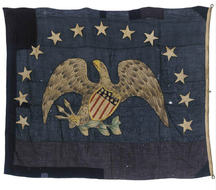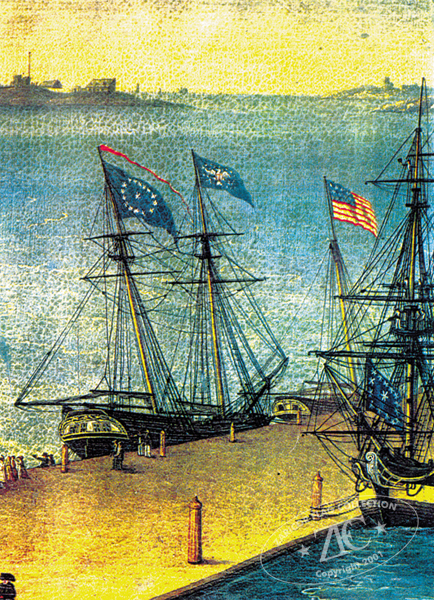

Obverse

Reverse - edit

Book Photo - edit

Reverse

Book Photo

Detail


13 Star S.S. Arctic U.S. Merchant Eagle Jack.
Sub-collection: Mastai - Early American Flags13 Star U.S. Commercial or Merchantman's Jack of S.S. Arctic, 1850s
This is an American Eagle jack styled after the eagle canton flags which became popular at the beginning of the 19th century. They were widely used at sea on commercial or merchant ships, in harbors and on rivers by steamboats.
These eagle jacks often complimented their ensigns, which often bore an eagle in the canton. The exact identity of the ship that flew this flag remains a mystery as at least seven ships bore the name Arctic during the 19th century, the period from which this flag dates.
This magnificent flag features the stylized arms of the United States: The American bald eagle bearing the arrows of defense and the olive branch of peace under an arc of 13 white, five-pointed stars. This large flag, stenciled "Arctic" on the hoist, was misidentified in the auction catalog as a Revenue Cutter Service Jack Flag. In fact, the flag conforms to no known jack ever used by the U.S. revenue cutter service, which never commissioned a ship christened "Arctic."

Note the flag usage recorded in this 1802 oil painting of the Salem Massachusetts dockyards. Peabody Essex Museum in Salem, MA.
A jack is any flag which is displayed on a jackstaff in the bow of a boat. In United Kingdom the practice is confined to vessels of the Royal Navy. The United States Navy also flies a jack on ships, but the proscription does not extend to the merchant marine in the United States.
Commercial ships which bore no commission were freed from the strictures imposed on commissioned ships of the United States with regard to jacks, house flags, private signals and other flags. Often referred to as jacks, they could be seen on the jack staff. Contemporary paintings show jacks flown on locations other than the bow, such as the rigging, especially when dressing a ship for a launching, christening or other celebration.
Acquired from Sotheby's Auction in New York City on October 10, 2002. Mastai Lot No. 99. To be framed April 2003.
Exhibition History:
Second Presidio Exhibit
2003 Gallery III
(ZFC0621)
13-Star American Commercial or Merchantman's Jack, of S.S. Arctic
Publication History:
Madaus, Howard M., Dr, Whitney Smith, The American Flag: Two Centuries of Concord and Conflict. Santa Cruz: VZ Publications, 2006, pp. 56-57.
Provenance:
• S.S. Arctic, 1850/54.
• Acquired by Mr. & Mrs. Boleslaw & Marie-Louise d'Otrange Mastai, New York City, and Amagansett, NY, The Mastai Collection, until 2002.
• Sold via Sotheby's Auction in New York City to the Zaricor Flag Collection, 2002.
Sources:
Madaus, Howard M.- Whitney Smith, The American Flag: Two Centuries of Concord and Conflict, VZ Publications, Santa Cruz, 2006.
Jack of the United States, Wikipedia, 14 November 2011, from: http://en.wikipedia.org/wiki/Jack_of_the_United_States
Union Flag, Wikipedia, 14 November 2011, from:
http://en.wikipedia.org/wiki/Union_Flag
Brig Arctic, 1826, Immigrant Ships Transcribers Guild, 14 November 2011. From: http://www.immigrantships.net/v4/1800v4/arctic18260907.html
Ship Arctic,1851, Liverpool to New York, Irish Emigration Database, 14 November 2011. From: http://ied.dippam.ac.uk/records/47706.transcript
SS Arctic, Wikipedia, 14 November 2011, from:
http://en.wikipedia.org/wiki/SS_Arctic
Image Credits:
Zaricor Flag Collection.
Hoist & Fly | |
|---|---|
| Width of Hoist | 88 |
| Length of Fly | 105 |
Stars | |
|---|---|
| Comments on Star Measurements | Stars are cotton |
| Size of Stars | 8 |
Stripes | |
|---|---|
| Size of Hoist | 2 |
Frame | |
|---|---|
| Is it framed? | yes |
| Frame Height | 99 |
| Frame Length | 116.5 |
Stars | |
|---|---|
| Number of Stars | 13 |
| How are the stars embeded? | Machine Stitched |
| Are there stars on obverse? | yes |
| Are there stars on reverse? | yes |
Stripes | |
|---|---|
| Has a Blood Stripe? | no |
Crest/Emblem | |
|---|---|
| Description of Crest/Emblem | Painted Eagle with shield showing seven (7) stars and nine (9) stripes. |
Nationality | |
|---|---|
| Nation Represented | United States |
Fabric | |
|---|---|
| Fabric | Wool |
| Comments on Fabric | Stars are cotton. Bunting |
Stitching | |
|---|---|
| Stitching | Machine |
Attachment | |
|---|---|
| Comments on Method of Attachmen | Rope in a sleeve with metal rings. Rope through header |
| Method of Attachment | Roped-header |
Applica | |
|---|---|
| Applique Sides | Double Sided = Two sides different |
Documentation | |
|---|---|
| Research Documents | |
| Public Copy & Signs | |
| Press | |
Condition | |
|---|---|
| Condition | Good |
| Damage | used |
| Displayable | yes |
Date | |
|---|---|
| Date | 1850s |
Exhibits | |
|---|---|
| Exhibition Copy | Second Presidio Exhibit 2003 Gallery III (ZFC0621) 13-Star American Commercial or Merchantman's Jack, of S.S. Arctic Date: About 1850-1870 Media: Wool bunting with cotton appliqué and painted-over details Comment: The Union Flag of Great Britain was established in 1606 to symbolize the joining of the England and Scotland under the common crown of King James I. It was not, however, the main flag of the king's ships but was used as a secondary identifying flag to be flown from a gaff positioned at the bow of the king's ships. In 1634, a proclamation was issued that prohibited all but the Royal Navy from flying the Union Jack at the bow of British ships. In 1674, this restriction was re-emphasized, at the same time that the red ensign was established as the official flag of British merchant ships. Nevertheless the prohibition was difficult to enforce and often more honored in the breach than not. Merchant ships continued to illegally utilize the Union Jack initially because it granted certain privileges in French and Dutch ports and also because it thwarted impressments of seamen by larger naval vessels. Impressments of American sailors would prove a friction point between England and the fledgling United States in the first decade of the 18th century. The issue was one of the primary causes of the war of 1812. Unlike English law, American naval practice didn't prohibit American merchantmen from flying their nation's colors as a jack on the ship's bow. Because they gave the intimidating impression that the ship flying such a flag was a U.S. Naval vessel, many American merchantmen outfitted their ships with not only the American ensign, but also with a jack flag that copied the canton (the union) of the U.S. flag. Provenance: Acquired by the Zaricor Flag Collection (ZFC0621) in 2002 from the Mastai collection of New York City through auction at Sotheby's. |
Publications | |
|---|---|
| Publication Copy | Madaus, Howard M., Dr, Whitney Smith, The American Flag: Two Centuries of Concord and Conflict. Santa Cruz: VZ Publications, 2006, pp. 56-57. 13-Star American Commercial (Merchantman's) Jack of the S.S. Arctic The Union Flag of Great Britain was established in 1606 to symbolize the joining of the England and Scotland under the common crown of King James I. It was not, however, the main flag of the king's ships but was used as a secondary identifying flag flown from a jack staff positioned at the bow of those ships. In 1634, a proclamation was issued that prohibited all but the Royal Navy from flying the Union Jack at the bow of British ships. In 1674, this restriction was re-emphasized, at the same time that the Red Ensign was established as the official flag of British merchant ships. Nevertheless the prohibition was difficult to enforce and often more honored in the breach than not. Merchant ships continued to illegally utilize the Union Jack initially because it provided several privileges in French and Dutch ports but primarily because it inhibited the impressment of seamen by larger naval vessels. Impressment of seamen would prove a friction point between Britain and the fledgling United States in the first decade of the 18th century. Unlike English law, nothing in American naval practice prohibited American merchantmen from flying jack flags. Many American merchantmen outfitted their ships with not only the American ensign, but also with a jack flag that copied the canton (union) of the U.S. flag. Some American commercial flags often incorporated the U.S. coat of arms into the union with the stars. Commercial jacks accordingly complemented their ensigns and similarly bore the U.S. coat of arms. This commercial jack was used by the ship Arctic; however, at least seven commercial vessels carried that name in the period in which this flag dates. Date: About 1850 - 1870 Size: 88" hoist x 105" fly Media: Wool bunting with cotton applÃqué and overpainted details Provenance: Acquired by the Zaricor Flag Collection in 2002 from the Mastai Flag Collection through auction at Sotheby's of New York City. ZFC0621" |








